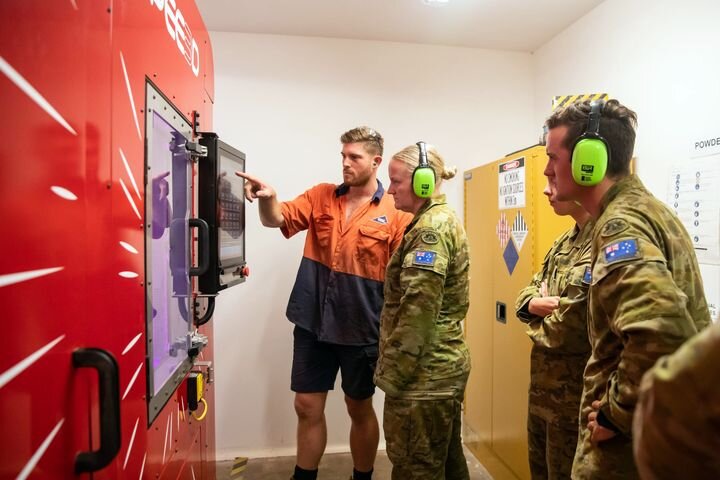![Australian soldiers learning how to 3D print in metal [Source: SPEE3D]](https://fabbaloo.com/wp-content/uploads/2020/05/image-asset_img_5eb0508ea209b.jpg)
SPEE3D has made an arrangement with the Australian military for a 12 month trial of their speed metal 3D printing technology.
The Darwin-based company has made some waves in the 3D printing community with their supersonic 3D printing process. The method involves blasting metal particles at literally supersonic velocities at a build plate, where the kinetic energy causes the particles to bond together upon impact.
SPEE3D Supersonic 3D Printing
Their process has some advantages and disadvantages. The prime advantage is, of course, the speed of 3D printing. SPEE3D can produce reasonably-sized metal objects in a very short time. To demonstrate their print speed, they 3D printed a “Thor Hammer” in only ten minutes at Formnext, live, in front of curious attendees.
Another major advantage to the SPEE3D process is that it can handle metals that are challenging to 3D print in other common metal 3D printing processes, such as powder bed / fusion. This allows them, for example, to easily 3D print copper, which happened to be the material used in the record-breaking Thor Hammer print.
One disadvantage is the resolution of the technology. It is difficult to produce very fine structures using SPEE3D’s approach. You could not, for example, 3D print one of those fine matrix-like cubes with a SPEE3D device. Every 3D printing process has its limitations and SPEE3D is no exception. However, the ability to 3D print relatively coarse objects is certainly extremely useful for many applications.
Military Use of SPEE3D
![Australian soldiers inspect a 3D printed metal part [Source: SPEE3D]](https://fabbaloo.com/wp-content/uploads/2020/05/image-asset_img_5eb0508f00d79.jpg)
SPEE3D announced a AU$1.5M deal with the Australian Ministry of Defence and Charles Darwin University to perform a 12-month trial of the metal 3D printing technology. Twenty soldiers will be trained in the use of the equipment and design of 3D objects for production.
Apparently the trial will begin with the production of ”non-safety critical repair parts” in the field.
SPEE3D Remote Use
One of the key factors in the military making this decision was the ability for SPEE3D technology to be used in the field. Unlike most other metal 3D printing processes, SPEE3D’s has relatively light requirements for additional equipment and facilities. This makes it much easier to install in remote locations.
Remote 3D printing should absolutely be of interest to the military. That business is constantly in need of spare parts for heavy equipment that breaks, and the supply chain to provide those parts can be quite arduous — and expensive.
By being able to 3D print parts on site, or at least in locations much closer to the action, significant time and expense can be saved. In wartime this could be a notable advantage. Thus it’s quite reasonable that the Australian military trial this technology.
But what of other militaries around the world? Should they not also be making use of 3D printing?
Via SPEE3D

